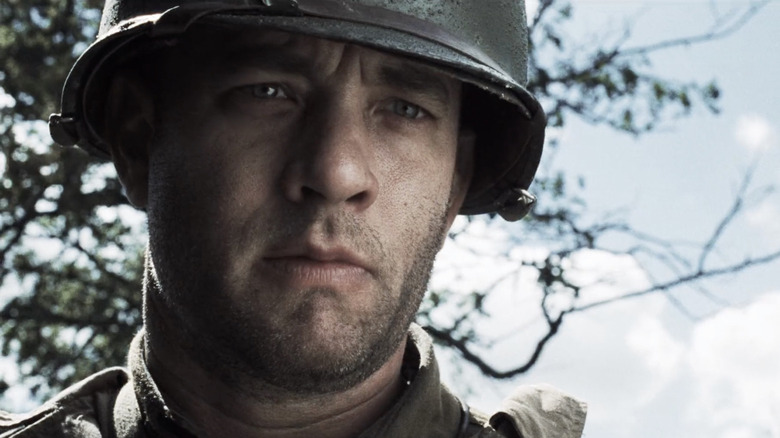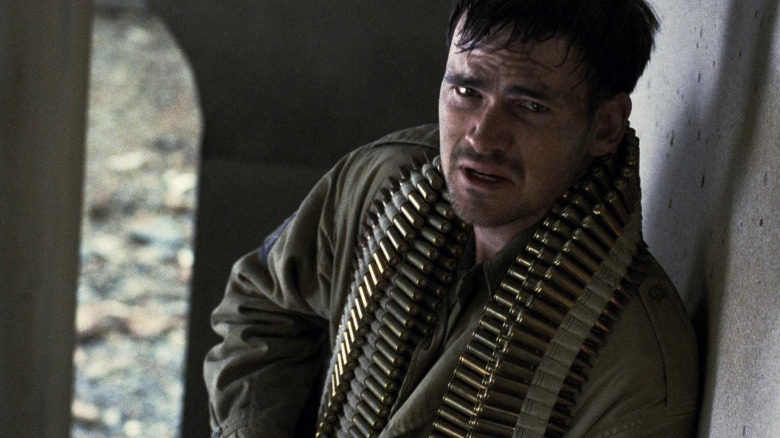The Split-Second Decision That Changed Saving Private Ryan
There's a game I like to play when watching a Steven Spielberg movie, be it for the first time or the umpteenth. It's called "Spot the Spielberg stand-in." Mind you, not every great director includes characters who serve as their self-inserts in their films, but Spielberg is very much one of them.
Naturally, his on-screen surrogates have changed over time. When a young Spielberg made "Jaws," it was the marine biologist Matt Hooper who acted as his avatar. (Really, between his beard and over-self-assurance, Hooper could have easily been the filmmaker in another life.) As the director has grown older, his stand-ins have aged and matured with him, taking on the forms of fathers, moral crusaders, and, most recently, seasoned storytellers who strive to pass their wisdom onto the younger people around them. There are even movies where two characters act as Spielberg stand-ins — namely, "Catch Me If You Can," where Tom Hanks' FBI agent Carl Hanratty and Leonardo DiCaprio's con artist Frank Abagnale come across as middled-aged and youthful versions of the director in conversation with one another.
Who's the Spielberg stand-in for Saving Private Ryan?
Who is the surrogate for Spielberg in "Saving Private Ryan," his landmark WWII movie? One could argue Hanks' haunted, world-weary Captain John H. Miller serves this role, and I would agree the director seems to relate to him the most early on. Yet, just as Ben Kingsley's Itzhak Stern acts as Spielberg's way into the harrowing events of "Schindler's List," it's Jeremy Davies' Corporal Timothy Upham who gradually emerges as the director's avatar, even if that wasn't originally the plan.
Stern in "Schindler's List" and Upham in "Saving Private Ryan" are similarly mild-mannered, bookish individuals who are brought into their movies' stories by other characters. But more than that, they're outsiders who are pulled into worlds they don't belong to (that of immoral war profiteers and battle-hardened soldiers, respectively), which is why they struggle to merely keep their heads above the water at first. This also makes them great self-inserts for most filmgoers, the vast majority of whom would be equally out of their element in these situations.
According to Davies, it was Spielberg who came to recognize this and, just as quickly, made the decision to change his approach during filming on "Saving Private Ryan." Here's what Davies told the Los Angeles Times when interviewed for an article marking the movie's 20th anniversary in 2018:
"Halfway through the shoot, Steven took me aside and said he'd seen some of the dailies, and that he'd been inspired to start telling 'Ryan' from Upham's POV. He told me that Upham represented the audience more than any other character, given that, of course, most of us will never experience war, and Upham was only trained to serve as an interpreter in noncombat situations."
How Upham became the film's POV character
Based on Davies' comments, I get the sense Spielberg initially saw Captain Miller as the POV character in "Saving Private Ryan." You can see this in the way the camera usually stays by his side during the incredibly brutal D-Day sequence that opens the movie, prior to Upham's first scene. Yet, as the film shifts its focus to Upham after that, Miller comes off feeling more and more like a stand-in for the generation of veterans who fought for the Allies in WWII (that is, the people Spielberg intended to honor with the movie, including his own father) than a figure who represents its director and audience.
This idea of Upham being the audience's guide — which, by default, also makes him the stand-in for Spielberg — manifests itself both visually and story-wise in the film, often as the result of other changes that Spielberg made on-the-fly during production. For example, as Hanks recounted in the 2017 documentary "Spielberg," the scene where Miller and his men attack a machine gun nest was originally quite different in terms of how it was meant to play out on-screen. However, when sunlight on the day of filming didn't allow for the coverage that Spielberg had wanted, the director made the split-second choice to depict the assault from the POV of Upham watching from afar with his monocular.
Perhaps most notably, as the Los Angeles Times' article revealed, the horrifying scene where Private Stanley Mellish (Adam Goldberg) is killed during a fight with a German soldier was more or less invented on the spot by Spielberg. As those who've seen the movie surely recall, this is when Mellish's opponent slowly stabs him in the chest with a knife while Upham sits on the opposite side of the wall between them, too terrified and shocked to move. It's not only a culminating moment for Upham's arc, it's also a deeply disturbing one, the power of which goes to show Spielberg was right in making the call to root so much of "Saving Private Ryan" in the corporal's perspective.


